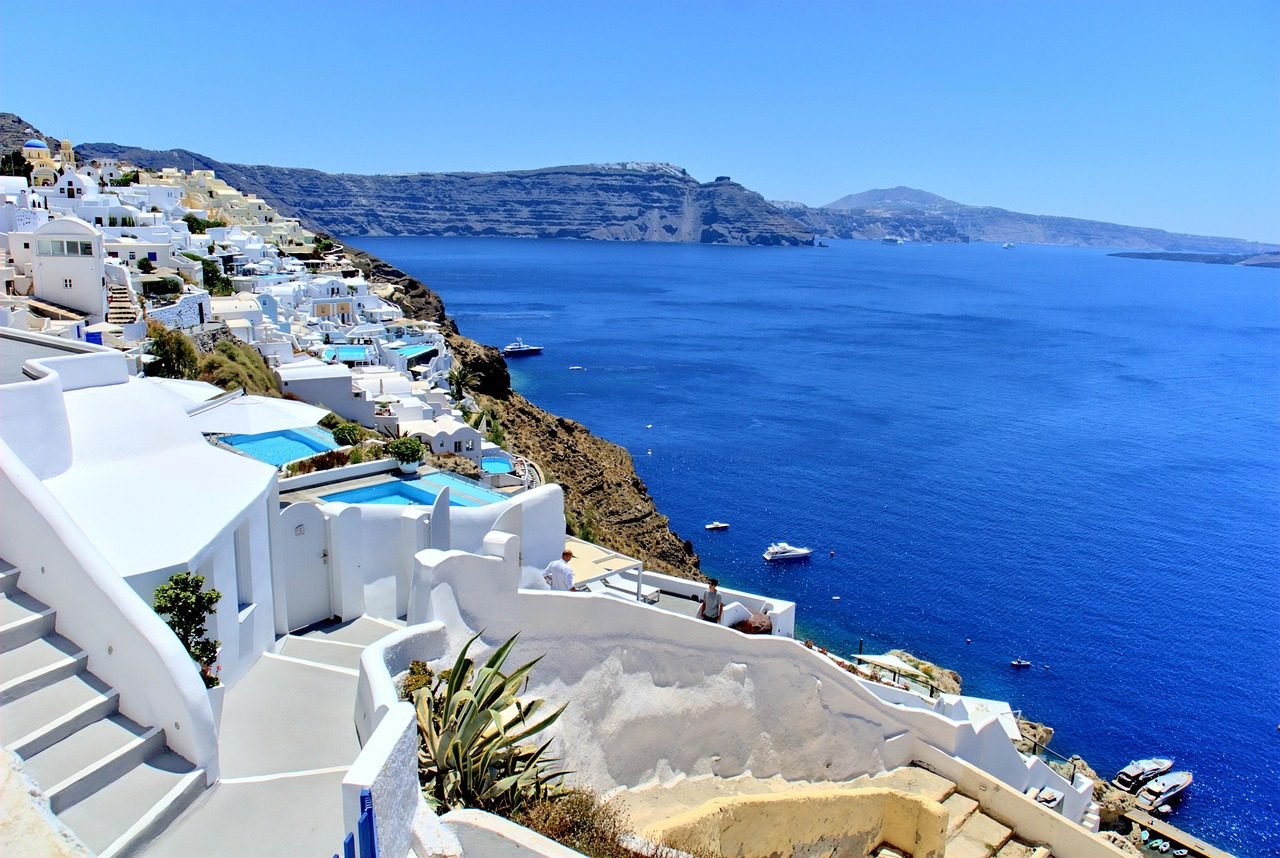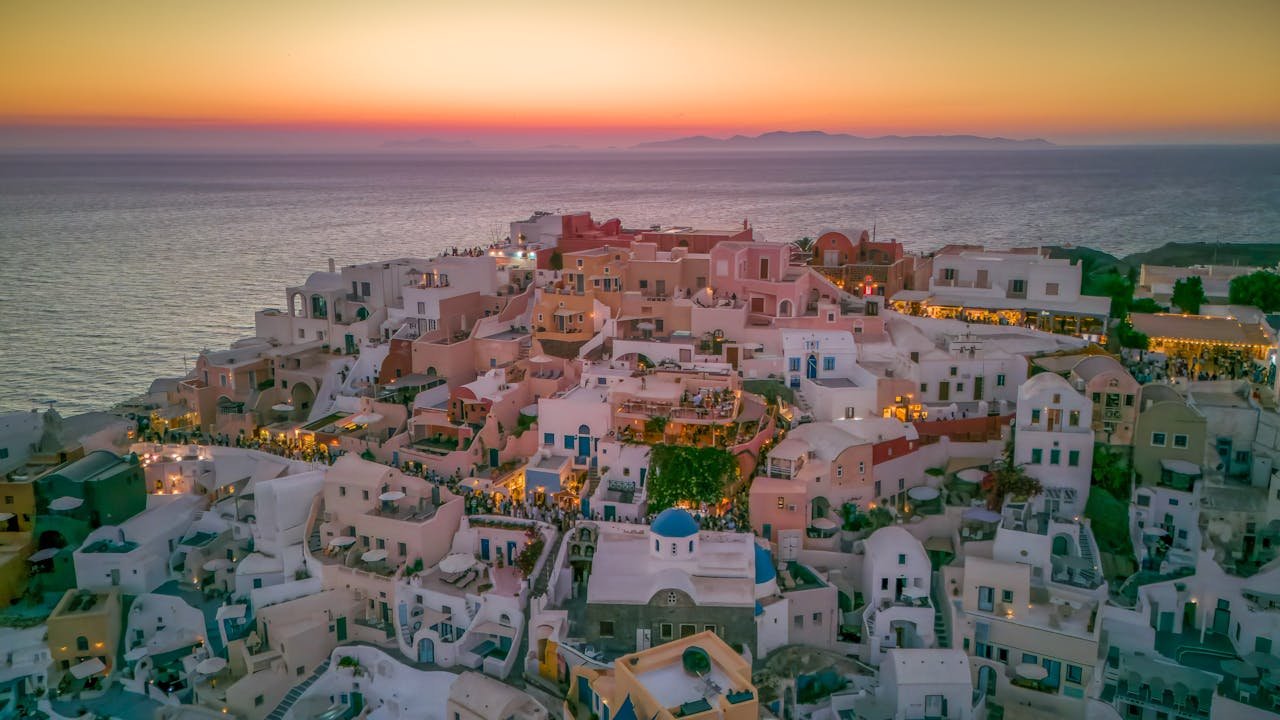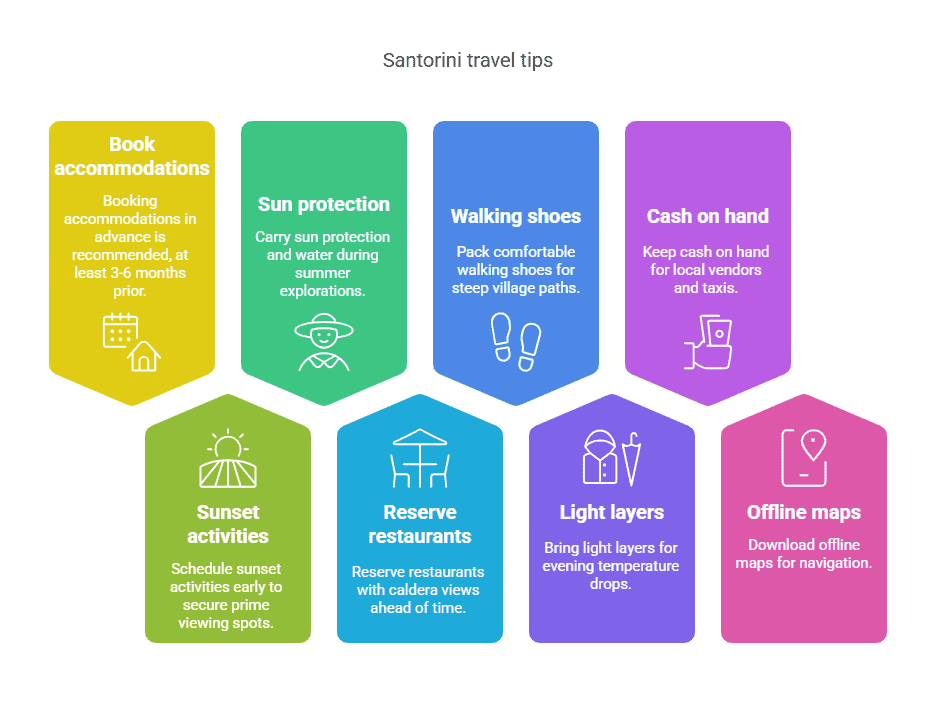Ultimate Santorini Travel Guide for Beginners: Tips and Highlights

This Santorini Travel Guide for Beginners welcomes you to one of the Mediterranean’s most breathtaking destinations, where dramatic cliffs meet crystal-clear waters. Perched on the rim of an ancient volcano, Santorini captivates visitors with its world-famous sunsets and distinctive architecture. Your journey through this Greek island will take you from iconic blue-domed churches to beaches of red and black volcanic sand. Whether you’re seeking romantic evenings in Oia, exploring ancient ruins, or sampling local wines in hillside vineyards, Santorini promises unforgettable moments that will stay with you long after your departure.
Key Takeaways:
- Oia village offers the most spectacular sunset views in Santorini, with its cascading white buildings and blue-domed churches creating a perfect backdrop for romantic evening moments
- While Santorini’s beaches aren’t typical white-sand paradises, their unique volcanic black, red, and white sand shores provide distinctive swimming and sunbathing experiences
- The island’s cave hotels and infinity pools carved into caldera cliffs deliver unmatched Mediterranean views and unforgettable luxury accommodations
- Traditional villages like Imerovigli and Firostefani offer authentic Greek charm with winding cobblestone paths, local tavernas, and fewer tourists than popular Oia
- Sunset sailing tours around the caldera combine wine tasting, swimming in hot springs, and breathtaking views of the island’s dramatic volcanic cliffs
The Magic of Santorini’s Architecture
Your journey through Santorini’s architectural landscape reveals a mesmerizing blend of traditional craftsmanship and natural adaptation.

The island’s unique building style emerged from centuries of working with the volcanic terrain, creating structures that are both beautiful and perfectly suited to the Mediterranean climate.
Iconic Whitewashed Buildings
After climbing the winding steps of Oia or Fira, you’ll understand why these dazzling white buildings have become a global symbol of Greek island life.
The limestone-based whitewash serves a dual purpose: reflecting the intense summer sun to keep interiors cool and acting as a natural disinfectant, protecting buildings for generations.
Traditional Cycladic Design
Design elements you’ll encounter showcase the perfect marriage of form and function.
The thick walls, small windows, and rounded edges characteristic of Cycladic architecture weren’t just aesthetic choices – they were imperative adaptations to the island’s climate and geography.
It’s fascinating to note that these architectural elements have remained largely unchanged since the 16th century.
You’ll find the same curved archways, vaulted ceilings, and blue-domed churches that have graced the caldera for hundreds of years, each feature carefully designed to withstand the Mediterranean elements while maintaining its timeless beauty.
Cave Houses and Infinity Pools
Across the caldera, you’ll discover the remarkable cave houses, carved directly into the volcanic cliff face.

These unique dwellings, many now transformed into luxury accommodations, offer natural temperature control and some of the most breathtaking views in the Aegean.
For instance, when you explore these cave houses, you’ll notice how they’ve been modernized while preserving their original character.
Over 60% of Santorini’s traditional cave dwellings now feature infinity pools that seem to merge with the sea below, creating an unforgettable fusion of historical architecture and contemporary luxury.
Best Sunset Viewing Locations
The magical sunsets of Santorini are world-renowned, drawing thousands of visitors each year to witness the sun’s dramatic descent into the Aegean Sea.
You’ll find numerous vantage points across the island where you can experience this daily spectacle, each offering its own unique perspective of the caldera and surrounding islands.
Oia’s Famous Sunset Point
Best known as the island’s premier sunset destination, Oia’s Castle ruins offer breathtaking 360-degree views of the caldera.

You’ll want to arrive at least an hour before sunset to secure your spot, as this location attracts up to 2,000 visitors during peak season.
The combination of whitewashed buildings, blue domes, and the setting sun creates a photographer’s paradise.
Imerovigli Viewpoints
Viewpoints in Imerovigli provide a more peaceful alternative to Oia’s crowds. You can enjoy unobstructed views from the village’s elevated position, 300 meters above sea level, making it the highest point of the caldera edge.

Oia’s crowds can be overwhelming, but in Imerovigli, you’ll find intimate viewing spots like Skaros Rock and Grace Hotel’s terrace.
These locations offer you the perfect blend of tranquility and panoramic views, especially during the golden hour between 7:00-8:30 PM in summer.
Sunset Sailing Experiences
With a sunset sailing tour, you’ll experience the caldera’s beauty from a unique perspective.

These 5-hour cruises typically include wine tasting, swimming stops, and front-row seats to the sunset spectacle away from the island’s crowds.
But sailing tours offer more than just sunset views. You’ll get to explore hidden coves, swim in volcanic hot springs, and enjoy traditional Greek meals prepared onboard.
Your captain will share local insights while you sail past ancient volcanic formations and witness the sun painting the white cliffs in shades of gold and pink.
Beaches and Coastal Areas
After exploring Santorini’s clifftop villages, you’ll discover that its beaches offer a unique volcanic charm unlike anywhere else in Greece. Santorini’s status as one of the world’s most-visited islands is partly due to its distinctive coastline, where dramatic cliffs meet crystal-clear waters of the Aegean Sea.
Red Beach and Volcanic Landscapes
Areas near Akrotiri showcase the stunning Red Beach, where towering rust-colored cliffs create a dramatic backdrop for your beach day.

The unique crimson-hued sand and pebbles are a testament to Santorini’s volcanic heritage, making this spot one of the most photographed beaches on the island.
Black Sand Beaches
One of your most memorable experiences will be walking on the distinctive black sand beaches of Perissa and Kamari.

These volcanic shores stretch for several kilometers, offering plenty of sunbeds and beachfront tavernas.
Another remarkable feature of these beaches is the natural heating effect of the black sand, which warms up quickly under the Mediterranean sun.
You’ll find the best swimming conditions between June and September when water temperatures reach a pleasant 25°C (77°F).
Swimming and Snorkeling Spots
Snorkeling enthusiasts will find paradise in the crystal-clear waters around Amoudi Bay and White Beach, where volcanic formations create an underwater wonderland teeming with Mediterranean marine life.

To make the most of your swimming experience, head to these spots early morning or late afternoon when the waters are calmest.
You’ll discover hidden caves and coves perfect for exploration, but always check local conditions as some areas can have strong currents.
The water visibility often extends beyond 20 meters, making it ideal for underwater photography.
Cultural Experiences
Keep your Santorini experience authentic by immersing yourself in the island’s rich cultural heritage.
From ancient ruins to modern-day traditions, you’ll discover a tapestry of history spanning over 4,000 years.
Your journey through Santorini’s culture will reveal the deep connection between the island’s volcanic past and its present-day customs.
Ancient Akrotiri Archaeological Site
After being preserved under volcanic ash for millennia, this prehistoric city of Akrotiri now stands as Greece’s answer to Pompeii.

You’ll walk through remarkably preserved three-story buildings, admire advanced drainage systems, and see stunning frescoes from the Bronze Age.
The site offers a fascinating glimpse into a sophisticated Minoan settlement that thrived around 1600 BC.
Wine Tasting and Vineyards
Tasting Santorini’s unique wines is an crucial cultural experience. The island’s volcanic soil and distinctive “kouloura” vine-training system produce exceptional varieties, particularly the crisp, citrusy Assyrtiko.

You’ll find over 20 wineries scattered across the island, many offering spectacular caldera views.
Plus, your wine journey can include visits to traditional wineries like Santo Wines or Venetsanos, where you’ll learn about the 3,500-year-old winemaking tradition.
The unusual growing method protects grapes from strong winds and allows them to draw moisture from morning dew, creating wines with distinctive mineral notes.
Local Cuisine and Tavernas
Archaeological evidence shows that Santorini’s unique agricultural products, like white eggplants and cherry tomatoes, have been cultivated for centuries.
You’ll discover these local delicacies in traditional tavernas, along with fresh seafood and distinctive fava bean puree.
To fully experience Santorini’s culinary heritage, venture into family-run tavernas in villages like Megalochori or Imerovigli.
Here, you’ll find dishes like tomatokeftedes (tomato fritters) and fresh grilled octopus. Many restaurants offer cooking classes where you can learn to prepare these local specialties yourself, taking home more than just memories.
Where to Stay
Unlike other Greek islands, Santorini offers diverse accommodation options to match your dream vacation. From clifftop suites to beachside villas, you’ll find your perfect stay.
For detailed insights, check out The Complete Santorini, Greece Travel Guide to explore the best locations based on your preferences and budget.
Luxury Cave Hotels
Beside the caldera’s edge, luxury cave hotels offer an extraordinary experience with private infinity pools and sunset views.

These architectural marvels, carved into the volcanic cliffs, combine traditional Cycladic style with modern amenities.
You’ll find most premium options in Oia and Imerovigli, with rates ranging from €500 to €2,000 per night.
Boutique Accommodations
Above the bustling streets, boutique hotels provide an intimate atmosphere with personalized service. These stylish properties, often family-owned, feature unique design elements and authentic Greek hospitality.
Considering your desire for a balanced experience, boutique accommodations offer excellent value.
You’ll discover properties with rooftop terraces, local art installations, and convenient locations near restaurants and shops.
Most boutique hotels in Fira and Firostefani range from €200 to €500 per night.
Traditional Guesthouses
Any budget-conscious traveler will appreciate traditional guesthouses scattered throughout Santorini’s villages.
These charming properties offer authentic Greek experiences at reasonable prices, typically including homemade breakfast and local wine tastings.
Hence, your stay in a traditional guesthouse connects you with local culture. Most properties feature whitewashed walls, blue-domed roofs, and courtyard gardens.
You’ll find excellent options in Karterados and Megalochori, with rates from €80 to €200 per night, perfect for experiencing genuine island hospitality.
Getting Around
For exploring Santorini’s enchanting landscape, you’ll find several convenient transportation options at your disposal.

The island’s compact size – just 76 square kilometers – makes it relatively easy to navigate, whether you’re heading to the caldera viewpoints or seeking hidden beaches. Any transportation choice will lead you to spectacular vistas.
Transportation Options
On Santorini, you can choose from local buses connecting major villages, rental cars for independent exploration, ATVs for adventure seekers, or private transfers for comfort.
The public bus system is reliable and affordable, running frequently between Fira and Oia. Any mode of transport offers unique perspectives of the island’s beauty.
Best Times to Visit
Above all, timing your visit to Santorini requires careful consideration of both crowds and climate.

The peak season (June-September) brings perfect weather but heavy tourism, while shoulder seasons (April-May, October) offer pleasant temperatures and fewer visitors. Any trip during spring showcases the island’s wildflowers in bloom.
And while summer months guarantee endless sunshine and warm seas, they also bring higher prices and crowded attractions.
Consider visiting in early May or late September when you can still enjoy swimming weather and stunning sunsets without the peak season crowds.
Practical Tips
Above all else, consider these important points for your Santorini adventure:

- Book accommodations at least 3-6 months in advance
- Schedule sunset activities in Oia early to secure prime viewing spots
- Carry sun protection and water during summer explorations
- Reserve restaurants with caldera views ahead of time
Any last-minute changes can affect your experience during peak season.
Due to Santorini’s growing popularity, planning ahead becomes increasingly important. Consider these additional insights:
- Pack comfortable walking shoes for steep village paths
- Bring light layers for evening temperature drops
- Keep cash on hand for local vendors and taxis
- Download offline maps for navigation
Any well-planned trip will help you maximize your Santorini experience.
Final Words
On the whole, your journey to Santorini promises to be an unforgettable blend of natural wonders and timeless charm.
As you explore the island’s enchanting whitewashed villages, bask in the warmth of world-famous sunsets, and discover hidden beach gems, you’ll understand why this Aegean paradise captivates travelers from across the globe.
Whether you’re seeking romantic moments in Oia, adventures in black sand beaches, or peaceful walks through historic paths, Santorini offers a perfect Mediterranean escape that will leave you planning your next visit before you’ve even departed.
FAQ
What is the best time to visit Santorini for perfect weather and fewer crowds?
The ideal time to visit Santorini is during the shoulder seasons of April to May or September to October.
During these months, you’ll enjoy pleasant temperatures around 20-25°C (68-77°F), stunning clear skies, and significantly fewer tourists compared to the peak summer months.
This timing allows for a more intimate experience of the island’s charm and better photo opportunities of those famous white buildings against the blue sea.
Where can I find the most spectacular sunset views in Santorini?
Oia village offers the most breathtaking sunset views on the island, particularly from the Byzantine Castle ruins.
Other remarkable viewing spots include Santo Wines Winery in Pyrgos, where you can enjoy the sunset with a wine tasting experience, Fira’s caldera walkway, and Imerovigli’s Skaros Rock.
For a unique perspective, consider booking a sunset sailing cruise around the caldera.
Which beaches in Santorini are must-visit locations?
Santorini’s unique volcanic history has created distinctive beaches worth exploring. Red Beach, with its rust-colored cliffs and pebbles, offers an otherworldly landscape. Perissa and Kamari beaches feature striking black sand and crystal-clear waters, perfect for swimming.
White Beach, accessible only by boat, provides an exclusive experience with its white cliffs and peaceful atmosphere.
What are the most photogenic spots in Santorini’s villages?
The famous blue-domed churches in Oia provide iconic photo opportunities, especially the Three Blue Domes viewpoint. Imerovigli’s winding pathways and pristine white buildings offer stunning caldera views.
The narrow cobblestone streets of Fira, lined with bougainvillea flowers, create perfect Instagram moments. The traditional village of Megalochori, with its bell towers and cave houses, offers authentic Greek charm away from the crowds.
How can I experience the best of Santorini’s local culture and cuisine?
Immerse yourself in Santorini’s culture by visiting local wineries to taste assyrtiko wine, grown in the island’s volcanic soil.
Try traditional dishes like fava (yellow split pea purée), tomatokeftedes (tomato fritters), and fresh seafood at family-run tavernas.
Visit the Akrotiri archaeological site to explore the preserved ancient Minoan settlement. Join a cooking class to learn about local ingredients and traditional recipes passed down through generations.




